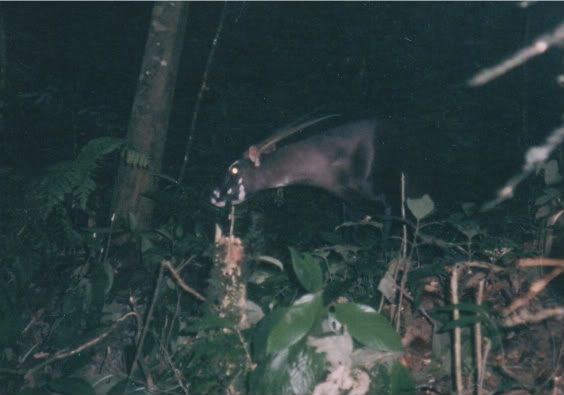Only discovered in 1992, the reclusive and beautiful saola Pseudoryx nghetinhensis may soon vanish from the Earth, if rapid action isn’t taken to save one of Asia’s most enigmatic and rare mammals. Listed as Critically Endangered, the species has experienced a sharp decline since its discovery due largely to poaching.
“The animal’s prominent white facial markings and long tapering horns lend it a singular beauty, and its reclusive habits in the wet forests of the Annamites an air of mystery,” says Barney Long, of the IUCN Asian Wild Cattle Specialist Group. “Saola have rarely been seen or photographed, and have proved difficult to keep alive in captivity…Its wild population may number only in the dozens, certainly not more than a few hundred.”

The only live adult Saola ever seen by the outside world. This female was captured in 1996 in Laos by local villagers, and transferred to a nearby menagerie, but survived only a few weeks. Copyright 1996 by W. Robichaud/WCS. |
There are no specimens being held in zoos, making reintroduction impossible should the species go extinct in the wild. Thirteen known individual saolas have been held in captivity, but all died within five months time, provoking the Ministry of Forestry in Vietnam to outlaw hunting, capture, or holding the animal.
Experts recently held an emergency meeting in Vientiane, Laos to plan a strategy to save the animal. Identifying snares and hunting with dogs as the main contributor to the species’ downfall, they agreed that it is necessary to increase the removal of poachers’ snares from the area and reduce the number of dog-hunts that occur in the Annamite region. Hunters pursue the saola for its meat and use its unique scent glands for medicinal purposes.
More awareness of the species and its plight in Vietnam and Laos will help, they agreed, but also increased funding from donors worldwide will be necessary if the species is to survive.
At the meeting the biologists also discussed improving methods to locate the shy bovine and begin a radio-tracking program.
While most closely related to wild cattle, the saola proved so strange on discovery that a separate genus was created for it. Standing 80 to 90 centimeters high the soala is said to most-resemble desert antelopes from Arabia. It’s small range extends along the valleys of the Annamite Mountains between Laos and Vietnam.
“We are at a point in history when we still have a small but rapidly closing window of opportunity to conserve this extraordinary animal,” says William Robichaud, Coordinator of the Saola Working Group, set up by IUCN’s Asian Wild Cattle Specialist Group. “That window has probably already closed for another species of wild cattle, the kouprey, and experts at this meeting are determined that the saola not be next.”
The kouprey is forest-dwelling ox, which is also classified as Critically Endangered and has no specimens in zoos. Like the saola the kouprey has been devastated by hunting. Even less is known about the kouprey than the saola, and a debate continues about its taxonomy.

Captive female soala. Copyright 1996 by W. Robichaud/WCS.

Wild Saola caught on film by an automatic camera-trap in central Laos in 1999. Photo by Ban Vangban village/WCS/IUCN.

Wild Saola caught on film by an automatic camera-trap in central Laos in 1999. Photo by Ban Vangban village/WCS/IUCN.
Related articles
Extinction of Christmas Island Pipistrelle bat predicted in less than six months
(06/03/2009) The Australasian Bat Society predicts that the Christmas Island Pipistrelle bat has less than six months left until extinction, unless measures are taken immediately to set-up a captive breeding population.
Tropical East Asian forests under great threat

(06/02/2009) Tropical East Asia’s rapid population growth and dramatic economic expansion over the past half century have taken a heavy toll on its natural resources. More than two-thirds of the region’s original forest cover has been cleared or converted for agriculture and plantations, while its flora and fauna have suffered dearly from a burgeoning trade in wildlife products: several charismatic species have gone extinct as a direct consequence of human exploitation. Nevertheless tropical East Asia remains a top global priority for conservation, supporting up to a quarter of the world’s terrestrial species.
Half of the world’s mammal species in decline (update)
(10/06/2008) Half of the world’s mammal species are in decline, according to a new assessment of the planet’s 5,487 mammals.















